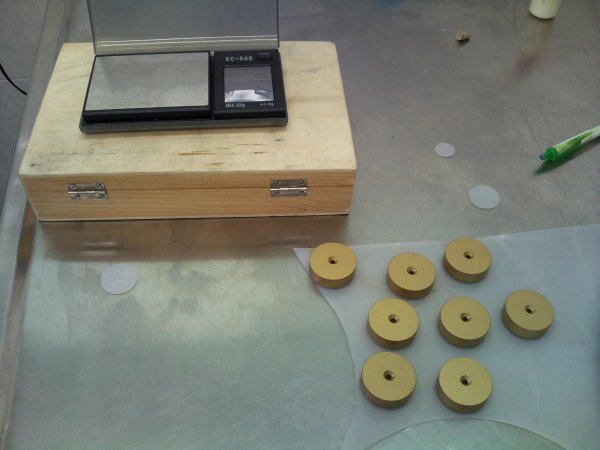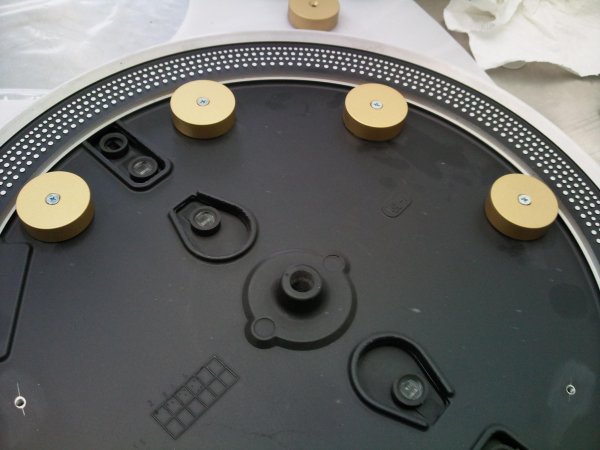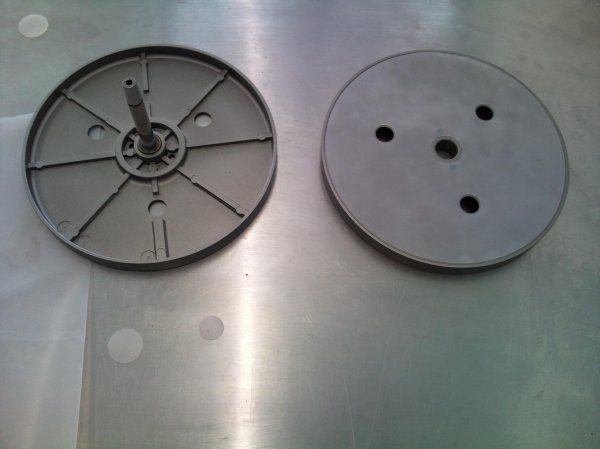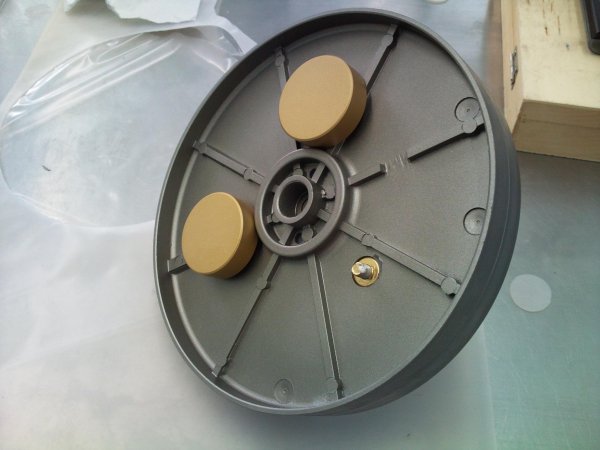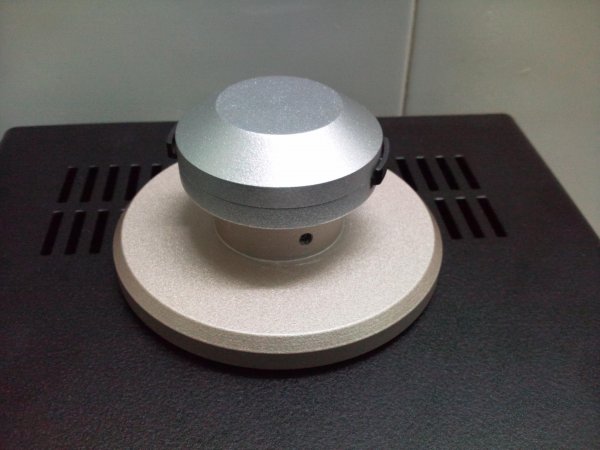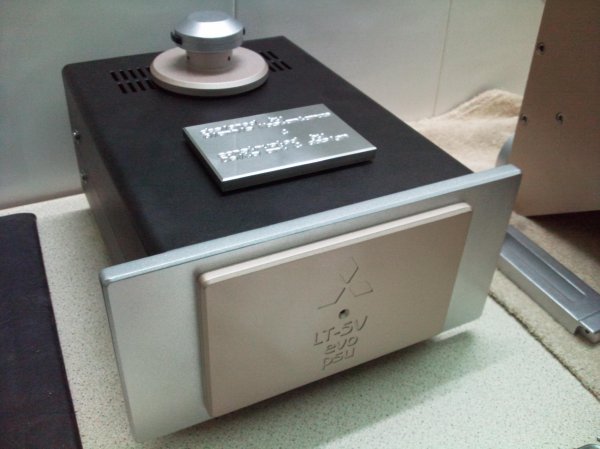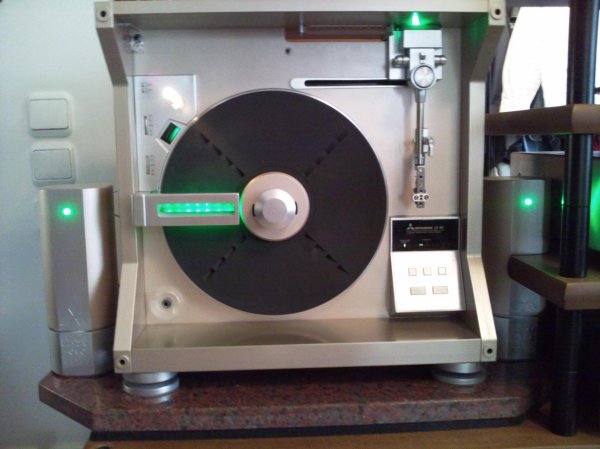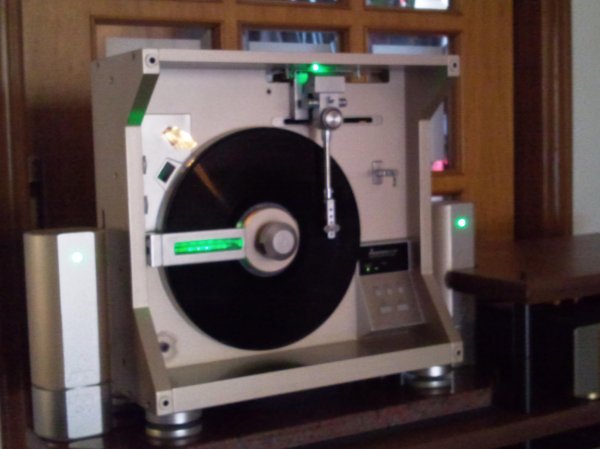The story of my Mitsubishi LT-5V turntable.
- Thread starter soundofvoid
- Start date
You are using an out of date browser. It may not display this or other websites correctly.
You should upgrade or use an alternative browser.
You should upgrade or use an alternative browser.
Last edited:
PART-10
On the electronics part,i took out the boards and renewed all capacitors with the best quality i could find,and changed the power transistors with newer more powerfull versions.
Old ICs where also renewed.
I worked on the PS caps too by using bigger capacitance plus PIO bypassing.A new toroid was ordered with 3 times the original wattage plus an extra 3 V output to power the leds
that i was going to use.The wires where trimmed to exact measures and initial tests started with powering the two motors .
The PS was holding on very well but the two motors would not work together!Upon pushing the start button both would start but after a couple seconds one would work and the other would stop!So simply running them in parallel would not cut it...
How about a buffer circuit that would trick the ICs into not sensing the other motor?
I had the service manual in hand and with the help of a friend i constructed a small board with such a circuit.
It worked,but proved very unstable.One little flick on the strobo controls and it would go haywire...
We tried other types of buffer circuits but the problem persisted...
Three months had past with electronics tests with no solid results!
The circuit proved very difficult to hack and i was getting desperate!
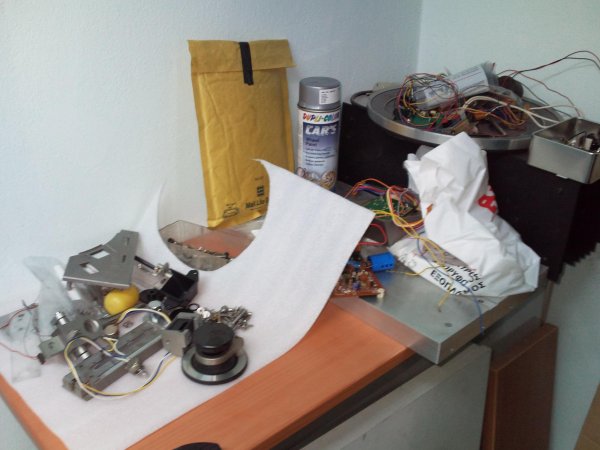
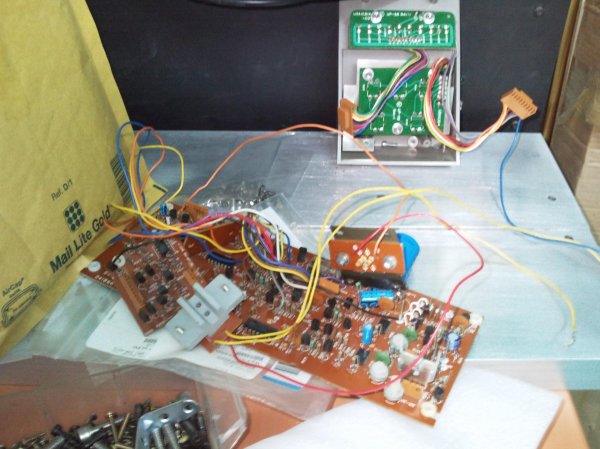
So i took a brave decision:I would add a second board (from my donor turntables) and use one board for each motor.
Again the second board was brought up to spec just like the first one.
Luckily it would juuust fit on the other side of the subplatter.
Of course that led to other small modifications that are too numerous to describe...
Hooked up the power and gave it a spin to see what happens...Disaster again!
Even with the second board feeding the second motor, it was still a very fragile balance.
What the hell was going wrong?The only places that the two boards "saw' each other
was a)the power supply
b) the buttons board
c) the stroboscopic trimmers
So i tried two power supplies and nothing changed...
I hooked up a second buttons board to the second board and again no results...
So i tried controlling the 33/45 speeds with another pair of trimmers and ...VOILA!Rock solid speeds from the first try!
Ok,now i knew the fix but where was i going to mount a second pair of trimmers?
NOWHERE YOU SILLY!Just buy double stacked pots and put them in the place of the originals!!!!
A nice guitar shop from Germany provided ALPHA 5K double pots that fitted veeeery tightly.They worked like a dream!
So all problems were solved on the electronics front!
What was left was the "decoration" problems that may seem small but are the ones that make or break a presentation!
Remember that i wanted "kick ass" looks?!
On the electronics part,i took out the boards and renewed all capacitors with the best quality i could find,and changed the power transistors with newer more powerfull versions.
Old ICs where also renewed.
I worked on the PS caps too by using bigger capacitance plus PIO bypassing.A new toroid was ordered with 3 times the original wattage plus an extra 3 V output to power the leds
that i was going to use.The wires where trimmed to exact measures and initial tests started with powering the two motors .
The PS was holding on very well but the two motors would not work together!Upon pushing the start button both would start but after a couple seconds one would work and the other would stop!So simply running them in parallel would not cut it...
How about a buffer circuit that would trick the ICs into not sensing the other motor?
I had the service manual in hand and with the help of a friend i constructed a small board with such a circuit.
It worked,but proved very unstable.One little flick on the strobo controls and it would go haywire...
We tried other types of buffer circuits but the problem persisted...
Three months had past with electronics tests with no solid results!
The circuit proved very difficult to hack and i was getting desperate!


So i took a brave decision:I would add a second board (from my donor turntables) and use one board for each motor.
Again the second board was brought up to spec just like the first one.
Luckily it would juuust fit on the other side of the subplatter.
Of course that led to other small modifications that are too numerous to describe...
Hooked up the power and gave it a spin to see what happens...Disaster again!
Even with the second board feeding the second motor, it was still a very fragile balance.
What the hell was going wrong?The only places that the two boards "saw' each other
was a)the power supply
b) the buttons board
c) the stroboscopic trimmers
So i tried two power supplies and nothing changed...
I hooked up a second buttons board to the second board and again no results...
So i tried controlling the 33/45 speeds with another pair of trimmers and ...VOILA!Rock solid speeds from the first try!
Ok,now i knew the fix but where was i going to mount a second pair of trimmers?
NOWHERE YOU SILLY!Just buy double stacked pots and put them in the place of the originals!!!!
A nice guitar shop from Germany provided ALPHA 5K double pots that fitted veeeery tightly.They worked like a dream!
So all problems were solved on the electronics front!
What was left was the "decoration" problems that may seem small but are the ones that make or break a presentation!
Remember that i wanted "kick ass" looks?!
Last edited:
PART-11
I had decided that my baby would look equally impressive from the front and back too!The front was almost ready but the back needed work as the incorporation of a second board
made things rather populated and the wirings were a mess!
I had to improvise new routes for the wiring to keep it as tidy as possible,and took measures for sheet steel covers for the boards.
Everything had to be covered up nicely and the only thing that could be seen from the back would be the back of the parallel tracking mech,
the board covers, and the rotating subplatter with the added bronze weights.
Again i had to prep and paint the covers and drill and tap the new holes for securing the covers.
All the rear cabling between the two boards was amassed with one big "tie around" plastic ribbon.
The covers were put in place and the whole thing started to look very neat!
Special order was made for the tonearm cabling and the interconnects to the phono stage.
Both were solid silver (monocrystal) :the MCS-300 and the D-501 Silver Hybrid with custom VdHul RCA jacks.
It took me 5 hours to pass through the magnesium tube and around all tonearm joints the MCS-300 (much thicker and stiffer than the MCS-150!)
The output cable (D-501) was routed outside of the board covers to keep it free from any interference from the electrics.
The cables that were coming out were four:the left motor,the power supply,the signal output and the right motor.
All were routed through the same port on the middle of the lower back side.
It was time for a visit to the local plexiglass shop.I ordered a lightly grey tinted 1cm thick piece of acrylic with rounded edges and an opening for the cables.
I did all the drilling for the securing holes because they were near the edges and i wanted absolute perfection...
A soft rubbery brownish strip was added between the metal and the plexi to form a tight non resonant fit.
Some 12 screws later the plexi was in place and the result was (to my eyes) outstanding.
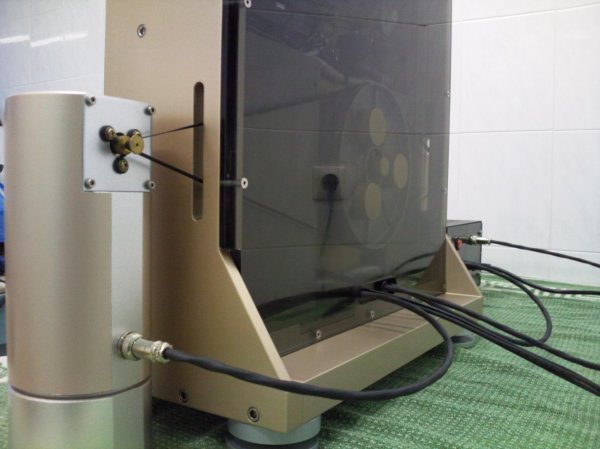
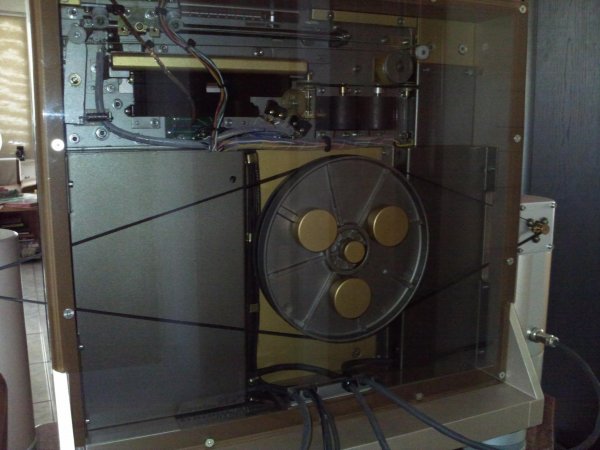
All that was left were the final touches on the front turntable side and the PS box...
I had decided that my baby would look equally impressive from the front and back too!The front was almost ready but the back needed work as the incorporation of a second board
made things rather populated and the wirings were a mess!
I had to improvise new routes for the wiring to keep it as tidy as possible,and took measures for sheet steel covers for the boards.
Everything had to be covered up nicely and the only thing that could be seen from the back would be the back of the parallel tracking mech,
the board covers, and the rotating subplatter with the added bronze weights.
Again i had to prep and paint the covers and drill and tap the new holes for securing the covers.
All the rear cabling between the two boards was amassed with one big "tie around" plastic ribbon.
The covers were put in place and the whole thing started to look very neat!
Special order was made for the tonearm cabling and the interconnects to the phono stage.
Both were solid silver (monocrystal) :the MCS-300 and the D-501 Silver Hybrid with custom VdHul RCA jacks.
It took me 5 hours to pass through the magnesium tube and around all tonearm joints the MCS-300 (much thicker and stiffer than the MCS-150!)
The output cable (D-501) was routed outside of the board covers to keep it free from any interference from the electrics.
The cables that were coming out were four:the left motor,the power supply,the signal output and the right motor.
All were routed through the same port on the middle of the lower back side.
It was time for a visit to the local plexiglass shop.I ordered a lightly grey tinted 1cm thick piece of acrylic with rounded edges and an opening for the cables.
I did all the drilling for the securing holes because they were near the edges and i wanted absolute perfection...
A soft rubbery brownish strip was added between the metal and the plexi to form a tight non resonant fit.
Some 12 screws later the plexi was in place and the result was (to my eyes) outstanding.


All that was left were the final touches on the front turntable side and the PS box...
Last edited:
PART-12
The front side plexi was more difficult to measure because i was after a total seal off of the front side (i have two kids!).
From early on i had designed it to hold in place with plastic male studs to female chassis cups like the ones used in speaker cloth frames.
This provides a very sturdy fit and prevents small kids hands for poking inside...
The first example made from 1 cm thick plexi was a bit off at the sides, but the second was spot on.
I had also incorporated openings at the plexi sides, to help in pushing it in and out.
The fit was perfect and secure - everything i wanted!
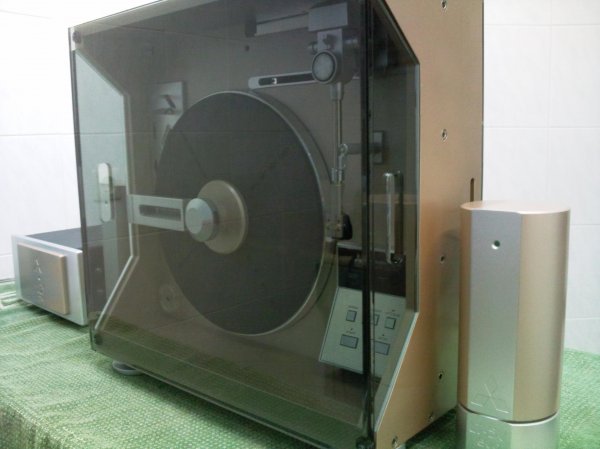
Then it was time for the plexi back of the PS box.I had ordered the part but i did the all the cutting for on/off swith,IEC receptangle,lemo type output to turntable.
I had done all the lettering in my computer and printed it on a self adhensive sheet that was positioned on the back side of the plexi.
The result was very proffesional looking...
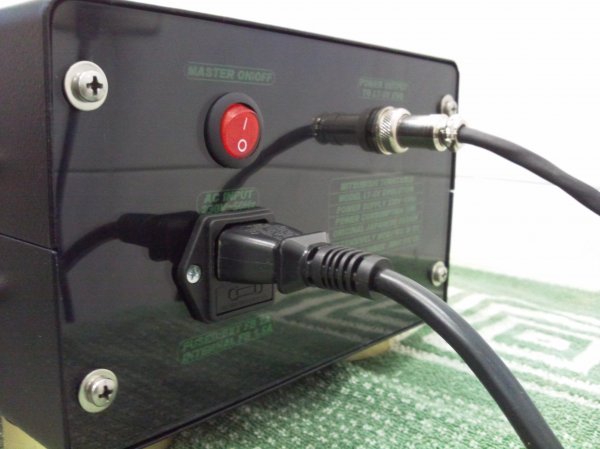
A few bits and pieces were left...
The front side plexi was more difficult to measure because i was after a total seal off of the front side (i have two kids!).
From early on i had designed it to hold in place with plastic male studs to female chassis cups like the ones used in speaker cloth frames.
This provides a very sturdy fit and prevents small kids hands for poking inside...
The first example made from 1 cm thick plexi was a bit off at the sides, but the second was spot on.
I had also incorporated openings at the plexi sides, to help in pushing it in and out.
The fit was perfect and secure - everything i wanted!

Then it was time for the plexi back of the PS box.I had ordered the part but i did the all the cutting for on/off swith,IEC receptangle,lemo type output to turntable.
I had done all the lettering in my computer and printed it on a self adhensive sheet that was positioned on the back side of the plexi.
The result was very proffesional looking...

A few bits and pieces were left...
PART-13
These were the lettering on the front strobo/speed regulation cluster and the headshell.
The original lettering was burried under the new painted surface, and again i designed in my computer and printed in a self adhesive clear sheet the new lettering.
A nice cutting and voila: back on it's place...
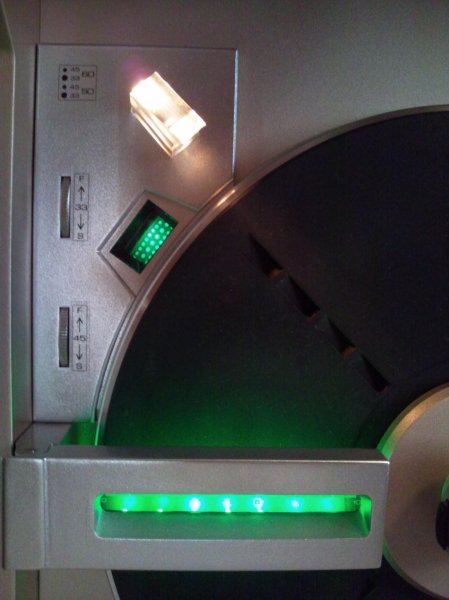
The headshell is not the original part but a rare magnesium SONY VEGA item that i had bought from
a seller in Japan (not cheap!).
To lighten it even further (and break any resonances) i drilled a series of holes into it.
I think it looks like a million $ and mates wonderfully with my Condor.
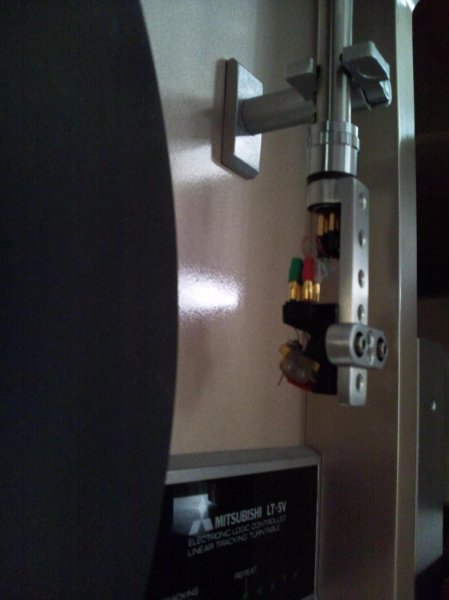
This was the final touch to my design...
Two people were needed to curry it home...
A shelf on my stereo furniture had to be cut a bit for the right motor to fit in.
A custom cut and polished, 3 cm thick,african red granite plate was used to place it on.
Under it, a type of rubber with small air bubbles is used to decouple it from the shelf-
(the only "soft" material that i could find that would not deform from the weight).
The final weight of the turntable alone was measured to be 65 kilos!
Each motor tower weighs 13.5 kilos.That is 92 kilos of turntable on the granit plate!
Adds about to more than a hundred K with the power supply...
I had what i wanted:a rigid heavy construction,twin motors,beefy power supply,looks to die for,
upgraded parrallel tracking AND green leds!
The whole project took me 4 years to accomplish.
I also costed me around 5000 euro plus most of my free time for years...
Was it worth it?
Let's say that this one is my last turntable.I will never sell it or replace it...ever!
These were the lettering on the front strobo/speed regulation cluster and the headshell.
The original lettering was burried under the new painted surface, and again i designed in my computer and printed in a self adhesive clear sheet the new lettering.
A nice cutting and voila: back on it's place...

The headshell is not the original part but a rare magnesium SONY VEGA item that i had bought from
a seller in Japan (not cheap!).
To lighten it even further (and break any resonances) i drilled a series of holes into it.
I think it looks like a million $ and mates wonderfully with my Condor.

This was the final touch to my design...
Two people were needed to curry it home...
A shelf on my stereo furniture had to be cut a bit for the right motor to fit in.
A custom cut and polished, 3 cm thick,african red granite plate was used to place it on.
Under it, a type of rubber with small air bubbles is used to decouple it from the shelf-
(the only "soft" material that i could find that would not deform from the weight).
The final weight of the turntable alone was measured to be 65 kilos!
Each motor tower weighs 13.5 kilos.That is 92 kilos of turntable on the granit plate!
Adds about to more than a hundred K with the power supply...
I had what i wanted:a rigid heavy construction,twin motors,beefy power supply,looks to die for,
upgraded parrallel tracking AND green leds!
The whole project took me 4 years to accomplish.
I also costed me around 5000 euro plus most of my free time for years...
Was it worth it?
Let's say that this one is my last turntable.I will never sell it or replace it...ever!
Last edited:
What did you originally pay for this system?
Do you remember what the different parts of this cost? I remember seeing the turntable at a very high end specialty store back when I was in high school (70s/80s). I always thought that when I "made it big" I'd own one of these. I remember them being very expensive. Does $1000+ US Dollars sound right?
Any idea what a mint condition turntable goes for today?
Great post
JC
Do you remember what the different parts of this cost? I remember seeing the turntable at a very high end specialty store back when I was in high school (70s/80s). I always thought that when I "made it big" I'd own one of these. I remember them being very expensive. Does $1000+ US Dollars sound right?
Any idea what a mint condition turntable goes for today?
Great post
JC
PART 1
Just been back from vacations and i feel my batteries fully charged!
So i am going to write (in episodes) the story about my resident DIY turntable...
It all started back on 1986 when i finished high school and had successfully
entered the University community.My father bought me as a gift, a Mitsubishi
set of components (amp/preamp/cassette player/tuner and THE Turntable:the LT-5V) plus
floor standing danish Jamo speakers.
Poor man had to give a down payment and i had to help paying up the monthly payments
as the total was 4 times his monthly salary (a schoolteacher).About 1/3 of that was the
cost of the turntable and rightfully so!
IT WAS (AND STILL IS!) EYE CANDY!!!
It was vertical,the record had to be pushed onto the platter and stabilized with a clamp,
was completely automatic (record size sensing/speed set/cue in/end lift ) and was using
a complicated parallel tracking arm that in contrary to the norm had a (limited) pivot movement!
It was belt driven, with a motor that would rotate a sub-platter at the back, connected with
a polished steel rod with the platter on the front.Cartridge was an MM AudioTechnica.
There was not a single person that would come into our house and not gasp in amazement
looking at it!See below the "transparent" image that gives an idea of the mechanisms involved!
Through this turntable i listened all the records of my university years...It worked without
a single problem for years and years.
At times other turntables came and went (best was a DENON DP72L) but this was with me
always even after i made my own family and moved to my house.
Through the years i came to understand the way it worked,it's strong points and it's weak ones!
The parallel tracking mech was very well executed but a lot of things could be done to support
it's function.So at first, i took out the power supply and placed it in a separate case,took out the motor,placed it in a separate iron ''tower'' and used a longer belt to rotate the sub-platter.I have designed a different clamp that utilized a stiffer spring to gain better contact between records/platter.
Then i tossed away the original (rather flexible) feet and used in their place a solid 3cm MDF board
with Sony ES feet,used extra MDF boards to strengthen the chassis, changed the tonearm wires
to silver ones and bought a nice VDHul "The Frog" cartridge.Last of all i painted it black from
the original silver.With this transformation the sound moved up several notches and i was in content
for another seven years...
Until an audio friend saw it and said :"I WANT THIS ONE!" and had the money to back up his statement!
I knew that working samples of this were sold at ebay for around 150 euro,and so i promised my
friend that he could have mine the moment i could make a "new" one the way i have dreamed it!
I wanted rigid chassis construction,twin motors,heavier platter/sub-platter assembly,superb power regulation,better tracking and looks to die for.
So i bought two working samples to use as donors for all the parts i needed and started to design
the shape of things to come...
And on the second picture is the LT-5V in my system on the described (modded) shape,
Sorry for my late reply!
Mint working examples are around the 250-350$ mark...but ebay one-offs exist and you may find a good example for less.
Mint working examples are around the 250-350$ mark...but ebay one-offs exist and you may find a good example for less.
Congratulations, it's a thing of beauty - art.PART-13
The whole project took me 4 years to accomplish.
I also costed me around 5000 euro plus most of my free time for years...
Was it worth it?
Let's say that this one is my last turntable.I will never sell it or replace it...ever!
$400 was a small fortune back then.I had a LT-5V. Bought it in 1981 for $400 as a freshman in college and owned it 'till ca. 85, when it was replaced with a Thorens. Nice to see one so many years later.
My whole stereo system was about $450, and I drove a rusted out $600 1966 Mustang at the time.
$400 was a small fortune back then.
My whole stereo system was about $450, and I drove a rusted out $600 1966 Mustang at the time.
I saved every cent working security for a semester. Really, really wanted that 'table.
Have a question!!!
I have one of these (bought at Classic Audio 22 years ago, near...Hammersmith? Olympia?). I hardly ever use it. Same with the ReVox B795 that I also have, it has one fatal flaw that I cannot fix: as the servo arm correction motor starts, there is a definite audible "thump."
Now this makes sense. In physics you learn that the static coefficient of friction is higher than the dynamic version, e.g., when you drag something across the floor, it always requires more force to get it moving than keep it moving.
What perhaps should happen is, that motor should keep running VERY SLOWLY all the time. You need this anyways: the groove never stops. Then, perhaps that thump from the start and stop may be less audible.
Has anyone else experienced this? Any solutions?
Congratulations, it's a thing of beauty - art.
I have one of these (bought at Classic Audio 22 years ago, near...Hammersmith? Olympia?). I hardly ever use it. Same with the ReVox B795 that I also have, it has one fatal flaw that I cannot fix: as the servo arm correction motor starts, there is a definite audible "thump."
Now this makes sense. In physics you learn that the static coefficient of friction is higher than the dynamic version, e.g., when you drag something across the floor, it always requires more force to get it moving than keep it moving.
What perhaps should happen is, that motor should keep running VERY SLOWLY all the time. You need this anyways: the groove never stops. Then, perhaps that thump from the start and stop may be less audible.
Has anyone else experienced this? Any solutions?
No thump!
You must have an earth point floating.
The sound is grounded at first to escape this "thump".
It doesn't happen in my samples...
You must have an earth point floating.
The sound is grounded at first to escape this "thump".
It doesn't happen in my samples...
Fantastic piece of engineering and ambition. Bought one of these in early 80s and still have it. Suspect it will require a service and replacement belts but should be still in great condition. Currently in attic storage  . Having read this story I'm eager to have a look and give it a new life.
. Having read this story I'm eager to have a look and give it a new life.
Brilliant stuff.
Brilliant stuff.


